
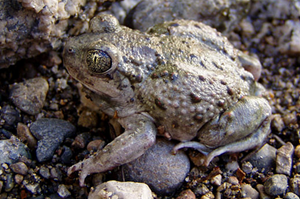
Western spadefoot (Scaphiopus hammondii).
The material presented in this section initially focused on amphibians local to the south San Francisco Bay region, in particular lands owned by the San Francisco Water Department in San Mateo County and Alameda Creek watershed, California. Most of the issues presented here can be generalized to other areas of California (e.g, Sierra Nevada) and probably any amphibian habitat, they all have problems. In fact many regions also suffer from perturbations carried in by larger circulation patterns. The watersheds of the Sierra Nevada Mountains, for example, suffer from agricultural pesticides and air pollution carried east from Central Valley by California’s prevailing wind patterns.
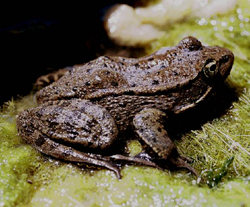
California red legged frog (Rana aurora draytonii).
Listen to the California red legged frog Recording 1, Recording 2.
This web page is not intended to be authoritative nor inclusive but rather provide some of the salient issues affecting native amphibians and provide insights into basic management opportunities that can make a difference to a vulnerable component of our environment.

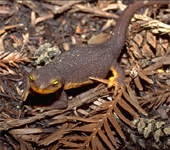
California newt (Taricha torosa torosa). |
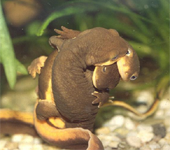
Mating rough-skinned newts (Taricha granulosa). |
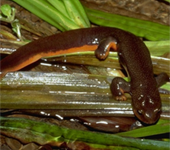
Rough-skinned newt (Taricha granulosa). |
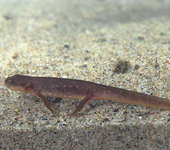
Larval rough-skinned newt (Taricha granulosa). |
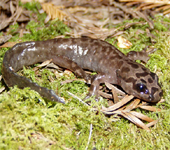
California Giant Salamander (Dicamptodon ensatus). |
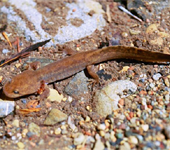
Larval California giant salamander (Dicamptodon ensatus). |
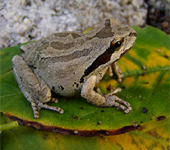
Pacific Tree (chorus) frog (Hyla regilla). |
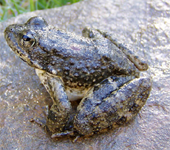
Foothill yellow legged frog (Rana boylii). |
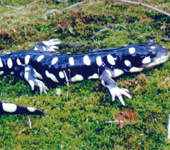
California Tiger Salamander (Ambystoma tigrinum californiense). |
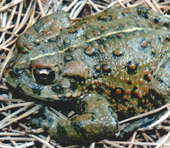
California (western) toad (Bufo boreas halophilus). |
• Total amphibian biomass can equal that of the small mammals within the region, and twice the biomass of birds during breeding season.
• The complex life cycle and permeable skin of make amphibians sensitive to changes in environmental conditions.
• Their sensitivity to environmental conditions make amphibians a good indicator of the ecological health of the City’s watersheds.

• Identification of native species: visual and auditory identification; habitat description.
• Introduced exotics: animals and plants.
• Sources and impacts of habitat loss.
• Habitat protection and restoration for native amphibians and other herps: priorities and application of management and monitoring tasks.
| Introduced Fish | |

Common carp (Cyprinus carpio). |

Largemouth bass (Micropterus salmoides). |

• Dewatering, damming and channeling of creeks: Change in natural seasonal flow patterns, reduced in creek habitat, slower stream flows, increased water temperatures and decreased dissolved oxygen (DO).
• Loss of cover and habitat conversion: Structural components of forests, rather than forest age per se, are the important features of the herpetofaunal ecosystem. Specifically, structural components near ground level where most herpetofauna occur, such as coarse woody debris, leaf litter depth and moisture, and understory vegetation cover are critical in maintaining the presence and abundance of amphibians and reptiles.
• Road kill.
• Movement of terrestrial material in to aquatic environment: e.g., sediment and nutrient loads.

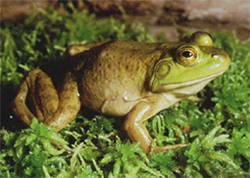
American bullfrog (Rana catesbeiana).
Listen to the American bullfrog,
bullfrog advertizement, bullfrog alarm.
• Make every effort to remove the bullfrogs from watersheds. Monitor for expansion of bullfrog populations.
• Remove the carp and bass from reservoirs and ponds.
• Eliminate water diversions from watersheds, enforce water rights for fish and wildlife as ‘beneficial uses’ in all watersheds.
• Many watersheds suffer from gratuitous cattle grazing. The removal of cattle grazing and reintroduce species such as Pronghorn antelope and/or Tule elk would reestablish a native ‘grazing’ regimes and would eliminate impacts to riparian habitat. This is the most efficient and fundamental improvement to native amphibian habitats possible.
• Remove ‘stock’ pond dams, allow restoration of natural spring flow patterns.
• Do not remove of down wood and trees from these watersheds. Eliminate the mechanized grubbing of riparian, oak woodland and chaparral vegetation communities.
• Reduce the road network within watersheds.

Amphibian Images
CalPhotos Berkeley Digital Library Project
• Pierre Fidenci, pfidenci@garciaandassociates.com
• William Flaxington, Fieldnotes@msn.com
• Joyce Gross, joyceg@cs.berkeley.edu
• Twan Leenders, Twan@scinax.com
• Henk Wallays, Henk.Wallays@skynet.be
Fish Images
• Henk Wallays, Henk.Wallays@skynet.be
Frog Calls
• Carlos Davidson, Frog and Toad Calls of the Pacific Coast (Vanishing Voices)
